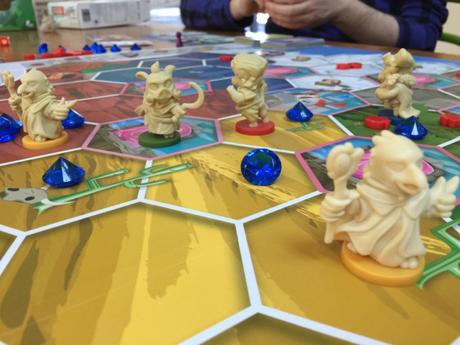Tabletop Review: 'My Little Scythe'
We used to do board game reviews on a weekly basis but...we haven't for a while. So let's do some more. And let's start with something a bit...off kilter.
'Scythe' was an incredibly well received resource and territory management strategy game that was released following a successful Kickstarter, and remains one of the best and most famous titles to come off that platform. 'Scythe' is, in a word, bleak.

Set in an alternate history 1920s the advanced technology only seems to make the world feel more hostile (I believe 'dieselpunk' is the term). It's all military regimes, farmers and miners scratching out a living and the players determining how much of the people's affection can be sacrificed for economic advancement. It's all tied together in the foggy, grey art style.
'My Little Scythe', conversely, apes a My Little Pony: Friendship is Magic aesthetic.
A father/daughter team worked together to create this odd mashup of intellectual properties and the latter showed an interest in the game. They developed the game over the course of months and it was eventually published by the publishers on the original 'Scythe'. The most surprising part of 'My Little Scythe' is how well it incorporates the 'Scythe' mechanics, instead it simplifies the options available to streamline the experience.

For those unfamiliar with the original and this new release, the mechanics are as follows. Each player rules one kingdom of up to five and controls two 'Seekers', animal characters represented by nice, chunky minis. These animal characters are based on the pets kept by the rulers of each faction in 'Scythe'. The goal is to be the first to achieve four Trophies, each obtained for completely one of eight different goals including delivering resources to the castle, completing two Quests, winning a combat, earning two upgrades, and so forth.
One each turn the players chose an action different to their previous one, meaning that some forward planing is needed. You can move your Seekers, dragging resources around with them, 'Seek' by rolling dice and placing resources (apples and gems) in different regions of the map, or build upgrades, magic spells or pies (each of which are used in combat). By moving around the map Seekers pick up Quests that offer rewards for picking a good or bad choice or engage in a pie fight with other characters.

This may sound like a lot for a game aimed specifically at family members of all ages, but we've played it with a couple of different 8 and 5 year olds and with a bit of coaching they all managed to pick up the rules. In spite of giving the player many options and play styles it remains higher accessible to younger players.
The Friendship mechanic is a thematic element which seemed to have the biggest impact on the young players, as it gave them a clear sense of consequences for their actions. In addition to scoring a trophy by achieving a high Friendship score, the game penalises you by not allowing you any trophies if your Friendship drops below the default level. Friendship is lost my taking the hostile option on Quests or getting involved in Pie Fights, but can be gained by taking positive quest paths and placing found resources of spaces occupied by other players. It's surprisingly effective.

'My Little Scythe' is an accessible game that doesn't assume that younger players can't follow layered rules. 'My First Carcasonne' is fun, but it strips all the mechanics down to linking paths and leaves the result to pure luck. At present it's the most requested game in our house. Highly recommended.

